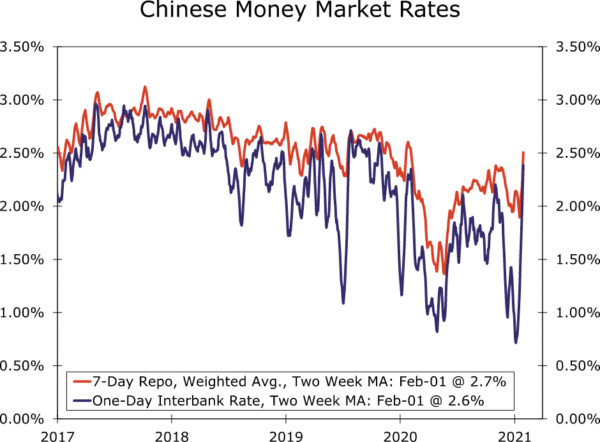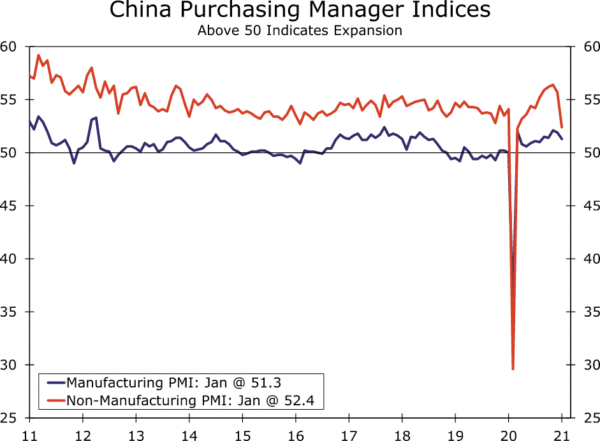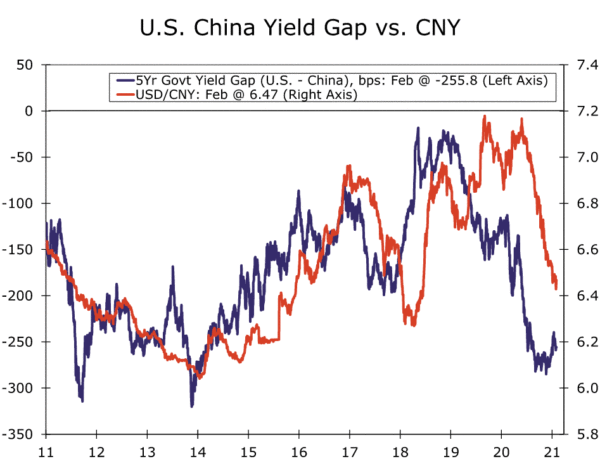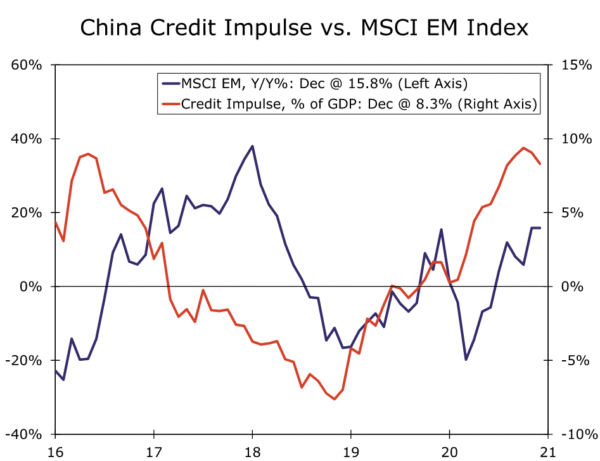Summary
For the past week or so, the People’s Bank of China (PBoC) seems to have engaged in sporadic operations that effectively tighten monetary policy in China. Pulling liquidity out of China’s financial system has pushed short-term borrowing rates higher, and supported the renminbi as well as other emerging Asian currencies. While it is unclear if the PBoC will continue to tighten policy as guidance from the Chinese central bank is limited, we believe further policy actions will be more tempered amid the Lunar New Year and recent COVID-related lockdown measures. However, further tightening of liquidity could result in a stronger Chinese currency than we currently forecast, while it could also result in large and long-term capital outflows from emerging market risk assets.
The economic recovery in China has been well documented over the last nine months. With Q4 GDP data now available, official statistics indicate China’s economy expanded 2.3% in 2020, the only major economy to experience positive growth last year. This economic outperformace has helped China’s financial markets and currency rally over the last 12 months. To put that into context, China’s main equity index, the Shanghai Composite, recently hit levels not seen since 2016, while the renminbi has trended toward CNY6.43, a level last reached in 2018 before U.S.-China trade tensions heated up. As China’s economy continues to outperform and attract capital flows, the People’s Bank of China (PBoC) suggest “bubbles” may be starting to form in local Chinese risk assets. In order to protect against overspeculation and a large financial market correction, the PBoC has sporadically removed liquidity from China’s financial system over the last few weeks.
We can point to the move in China’s one-day interbank repurchase rate as the most clear evidence of less accommodative policy from the PBoC. As of today, the one-day repurchase rate stood at 2.30%, up from 0.80% at the beginning of 2021, and up from 2.15% at the beginning of last week. Effectively, it would appear the PBoC has tightened monetary policy rather significantly since the start of the year, and has pulled ample amounts of liquidity out of China’s local financial system. The market reaction in the immediate aftermath of tightening opeartions has been swift. Last week, the Shanghai Composite index fell 3.5% and the CSI Shenzen index fell 4%, while 2-year government bond yields rose 18 bps. In addition, the Chinese renminbi rallied by about 1%, with renminbi gains also supporting most other emerging Asian currencies last week. In our January International Economic Outlook report, we laid out an upside scenario for the Chinese renminbi where the currency could strengthen more than we forecast. The scenario includes modest, but additional, monetary tightening from the PBoC. Given recent developments, it is possible monetary tightening could already be underway in China.
While recent operations suggest monetary tightening may be underway, we are hesitant to believe sustained and consistent PBoC tightening will materialize at this time. In the short-term, the Chinese Lunar New Year is around the corner and will take place in mid-February. Typically, the Lunar New Year period is a time for elevated travel, consumer spending as well as cash gifting across China. Chinese authorities, including the PBoC, are well aware of these dynamics and tend to make liquidity more accessible as well as cheaper over this time frame. Over the next few weeks, it would not be surprising if money market rates moved lower to accomodate the Lunar New Year. In addition, recent headlines indicate China is managing new COVID outbreaks in multiple provinces outside of Beijing. As a result, local lockdown measures have been reimposed in these provinces, restricting mobility and activity for about 11 million people. In our view, these restrictions are not enough to significantly disrupt China’s economy; however, recent data suggest restrictions may be having a mild impact on the economy. This past weekend, the January manufacturing PMI slipped to 51.3 from 51.9 and the non-manufacturing PMI fell to 52.4 from 55.7. Although still in expansion territory, prolonged or more stringent lockdowns could have a more material impact going forward. As mentioned, the Chinese economy is still an economic outperformer. However, given that COVID outbreaks are now showing up in data, the PBoC may not be willing to remove monetary accommodation at this time.
Although not our base case at the moment, further monetary tightening is still possible and represents an upside risk to our renminbi forecasts. Fleshing out our upside scenario in more detail is a worthwhile exercise given PBoC officials have already tightened policy. In the event COVID outbreaks are quickly contained post-Lunar New Year, it is possible PBoC authorities look to continue reducing risks related to asset bubbles and overspeculation. In this scenario, bond yields could push higher and the renminbi could strengthen rather sharply. The chart below of yield differentials between government bonds in China and the United States illustrates this point quite well. As of now, Chinese government bonds have a distinct yield advantage over similar maturity U.S. bonds. Using five-year yields, the gap is around 250 bps in favor of Chinese government bonds. At current levels, bond yield differentials suggest the renminbi could be stronger than where it is currently trading, possibly in the CNY6.20-6.25 range This yield differential is part of our rationale underpinning a view for a stronger renminbi over the medium-to-longer term, and as of now, we forecast USD/CNY to strengthen to CNY6.42 by the end of Q2-2021 and CNY6.36 by the end of this year. However, should the PBoC continue tightening policy, we would expect bond yields in China to trend even higher. With the Federal Reserve likely to keep monetary policy steady for the foreseeable future, it is entirely likely the yield spread widens in the renminbi’s favor even more. If the yield gap widens back toward 2011 or 2014 levels, it’s within the realm of possibilty the renminbi could reach the psychologically significant CNY6.00 level.
While tighter monetary policy could be supportive of the currency, it does come with associated risks. Given China’s influence within the emerging markets, pre-mature or pre-emptive tightening of monetary policy poses a risk to financial stability in China, Asia and the broader emerging markets spectrum. The risks to financial stability can be seen in the chart below which highlights China’s efforts to reduce credit accessibility and deleverage its economy amid debt sustainability and rising default rates in its non-financial corporate sector. We measure credit availability through a credit impulse measure, with the credit impulse index trending lower from 2016-2018 as deleveraging efforts intensified. As a result, the broader emerging markets equity index was relatively flat in 2017, and after a brief spike, sold-off 15% over the course of 2018. In an effort to offset tariffs, a structural economic slowdown and a more global economic deceleration, Chinese authorities resumed its leverage campaign and made credit more available starting in 2019. As the credit impulse index rose in 2019 and 2020, emerging markets equities also trended higher. That said, tighter monetary policy should lead to less credit stimulus to the Chinese economy. With emerging market economies still somewhat uncertain, tighter policy in China could lead to renewed capital outflows from the emerging markets and potentially broadly weaker EM currencies outside of China.

















